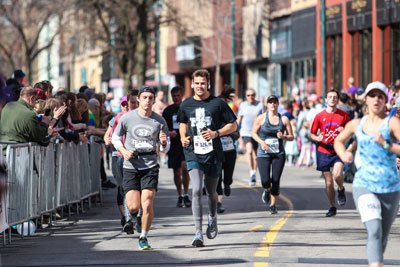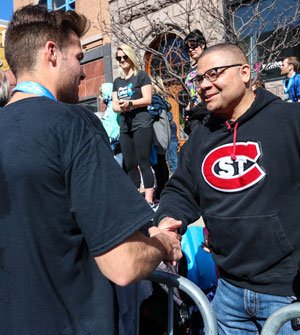Bryant Bohlig
Heart failure to half marathon
 Running a half marathon is challenging. Running it after experiencing a near-fatal heart condition and being placed on a heart transplant list is a whole different story.
Running a half marathon is challenging. Running it after experiencing a near-fatal heart condition and being placed on a heart transplant list is a whole different story.
But 22-year-old St. Cloud native, Bryant Bohlig, has never lacked determination.
“Sports was everything to me,” recalls Bryant as he reflected on his freshman year at St. Cloud Tech where he played quarterback for the football team.
He was raised in a family of star athletes, including his dad — a former coach at St. Cloud Tech as well as a brother and sister who played at the collegiate level.
And Bryant, the youngest, followed in their footsteps.
Right before a football practice in 2011, Bryant didn’t feel well.
His mother, June, a nurse at St. Cloud Hospital, thought he may have ruptured his appendix. She took him to St. Cloud Hospital and within hours, he was transferred to University of Minnesota Children’s Hospital in Minneapolis and put on a heart transplant list.
Pediatric Cardiologist Chip Martin-Chaffee, MD, CentraCare Health, helped to stabilize Bryant’s heart. He said the initial echocardiogram showed severely depressed heart function.
“In patients like Bryant, two-thirds of them either remain debilitated or even get worse and require heart transplantation,” said Dr. Martin-Chaffee.
“I literally broke down crying when they diagnosed him with congestive heart failure,” said June. “I prayed all the way to the University and asked all my friends and family to do the same.”
After furthering testing, it was determined that Bryant suffered from a heart condition called permanent junctional reciprocating tachycardia or PJRT. His heart was functioning at 10 percent capacity.
“I was a 14-year-old kid who was on his death bed and I was scared and terrified. I was playing football two days before and the next thing I knew, I was fighting for my life.”
“If congestive heart failure couldn’t take me down, this half marathon did not even stand a chance!”
~ Bryant Bohlig
Doctors needed to perform a procedure called an ablation to get his heart rate under control. He had arrhythmia, which meant the electrical impulses in his heart were not firing correctly.
“When I said goodbye to him as they took him to the Cath lab, I thought it would be the last time I would see him alive,” said June.
For Bryant, the procedure took just 45 minutes. And it worked. He would no longer need a heart transplant. But that was just the beginning of Bryant’s journey.
After the procedure, doctors told him that his chances of playing sports again were slim.
“I remember my mom had bought me brand new basketball shoes. When I came home from the hospital, I threw them away because I thought I would never be able to pick up a basketball again.”
The next step for Bryant was cardiac rehabilitation at St. Cloud Hospital, exercising side-by-side with 75-year-olds who couldn’t believe he was also a patient.
“I would wake up every morning at 7 a.m. to go ‘workout.’ When I say ‘workout,’ it was walking for 2 minutes and then resting for 5. The process was very slow, but I was comforted by the staff who guided me. They encouraged me every step. They monitored my heart, to assure I was OK to continue. It really helped me feel confident that my heart was OK, and I was safe to keep going.”
“Through appropriate evaluation, stabilization, intervention and medication treatment we were able to support Bryant’s heart and give it the chance it needed to rest and fully recover,” said Dr. Martin-Chaffee.
And through that support in cardiac rehab, Bryant got his motivation to someday return to the basketball court because of the confidence he was given by the doctors and staff.
“It was very self-motivating because I never saw a success story of a kid who had a heart condition get back on the court again. The training was tough, but I just kept moving forward and pushing myself,” he said.
Three months into rehab, Bryant was cleared to play basketball again.
“The feeling of proving the ‘medical journals’ wrong is an amazing feeling,” he said.
 Bryant went on to be a three-sport athlete in high school.
Bryant went on to be a three-sport athlete in high school.
Now in his 20s, Bryant wants to be an inspiration for other kids who have suffered from cardiac diseases — to provide hope for returning to the game or accomplishing other goals. And he put his words into action.
On April 20, Bryant ran the CentraCare Earth Day Run Half Marathon, raising money for pediatric cardiology patients at CentraCare.
“I ran a half marathon to accomplish a personal goal. But as I was training, I thought of my heart condition. I thought of what a miracle for myself to run 13.1 miles and then I thought of myself in the hospital. I thought of the hope I lost during that nightmare.”
Bryant admits that training for a half marathon was a “grind,” but his motivation is for the kids. And with the money he raises, he purchased items that can bring a “little distraction, little joy and laughter in their journey with heart disease.”
 “Ever since his near-death experience, he is a changed man,” said June. “He has become very close to the Lord and he has an incredible faith that he loves to share. He truly wants to be an inspiration to kids suffering with heart disease to somehow give them hope in their illness.”
“Ever since his near-death experience, he is a changed man,” said June. “He has become very close to the Lord and he has an incredible faith that he loves to share. He truly wants to be an inspiration to kids suffering with heart disease to somehow give them hope in their illness.”
The half marathon route went right by his family’s house where they were lined up, along with friends, to cheer him on as he ran on faith, motivation and inspiration.
But his family wasn’t the only cheerleaders.
“I congratulated him at the finish line,” said Dr. Martin-Chaffee. “But I reminded him that he’s already run the race of his lifetime … and won!”